| Diese Seite auf Deutsch! |
|
Leaf Snails (Hygromiidae) Part 2Trochulus, Petasina, Noricella |
| Leaf Snails (Hygromiidae) I | Leaf Snails (Hygromiidae) II | Leaf Snails (Hygromiidae) III | Heath Snails (Geomitridae) |
|---|---|---|---|
|
|
|
|
![]() Explanation
of Shell Characters for
Identification.
Explanation
of Shell Characters for
Identification.
Note: The genus name Trichia Hartmann 1840, in use until some time ago cannot be used anymore, because it is preoccupied by the older name of a Crustacean genus, Trichia De Haan 1839. Therefore, following scientific language, on this homepage the genus name Trochulus Chemnitz 1786 will be used. Since the genus name is male, the species names must be adapted accordingly - Trichia villosa therefore is to be called Trochulus villosus.
ICZN (2004): Opinion 2079 (Case 2926): Trichia Hartmann, 1840 (Mollusca, Gastropoda): proposed conservation; and Trichiinae Ložek, 1956 (Gastropoda): proposed emendation of spelling to Trichiainae, so removing the homonymy with Trichiinae Fleming 1821 (Insecta, Coleoptera) not approved - Bull. zool. Nomencl., 61 (3): 177 - 181, London.
Common Hair Snail - Trochulus hispidus (Linnaeus 1758)
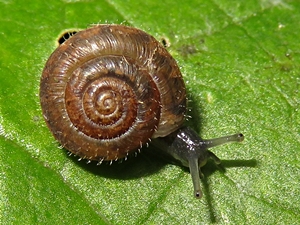 Trochulus hispidus: Zuid Holland, Netherlands. Photo: Rob Westerduijn (iNaturalist). |
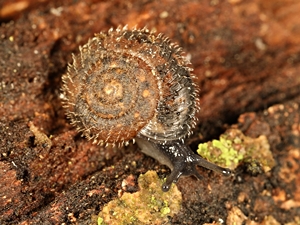 Trochulus hispidus: Oxelaëre, Nord-Pas-de-Calais, Frankreich. Bild: Marie Lou Le Grand (iNaturalist). |
 Common hair snail (Trochulus hispidus). Photo: Jean Huffman (iNaturalist): Ontario, Canada. |
Description: The common hair snail has got a depressed flattened shell, with a weakly coiled until flatly conical spire. The oblique aperture is flattened at the bottom side and displays a strengthened lip. The shell navel (umbilicus) is open and wide; it can widen to between 1/4 and 1/8 of the shell's diameter. The shell's surface is finely striped and covered with short, densely placed hairs (cf. Note). In older shell specimens, those can fall out and then leave scars on the shell surface. In dead specimens' shells they usually are completely absent.
Dimensions: W: 5 - 12 mm; H: 5 - 6 mm; N: 6 - 7.

Habitat and Distribution: The common hair snail occurs in light forests, in bushes and in man-made habitats, preferably on nettles. However, Trochulus hispidus avoids decidedly dry habitats. The snails can be found under old leaves, on deadwood and on the ground between nettles, as well as on plants themselves. Next to withering leaves, e.g. nettles, the common hair snail also feeds on mushrooms, fruit and petals.
The species is widely spread throughout Europe, with the exception of the northernmost landscapes of Finland, Scandinavia and Russia, as well as the Mediterranean Islands.
Note: According to a paper by Markus Pfenninger et al.: "Why snails have hairs", the shell hairs giving the genus their name and also to be found in juvenile cheese snails (Helicodonta), help the snails to better keep a hold on the wet leaves of plants they feed on. Additionally, the hairs also are used for camouflage by binding earth particles to the snail's shell (cf. photo of Trochulus sericeus).
Silky Hair Snail - Trochulus sericeus (Draparnaud 1801)
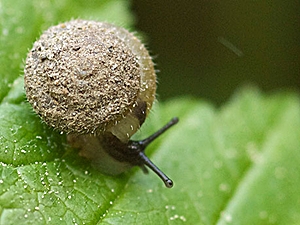 Silky hair snail (Trochulus sericeus) with camouflage. Photo: © Stefan Haller, (schneckenfoto.ch). |
Description: The silky hair snail has a roundish shell with rounded whorls displaying rougher growth lines, than those of the common hair snail (Trochulus hispidus). The shell surface shows long curved hairs. The apertural lip is weak and not rounded. The navel is very narrow. The shell size and hair length is locally very diverse.
Dimensions: W: 6 - 8,5 mm; H: 4,5 mm; N: 5 - 5½.

Habitats and Distribution: The silky hair snail lives in different places in marshy to moderately humid deciduous and coniferous forest, bushy and reed landscapes, as well as in humid to moderately dry meadows, alpine meadows and on castle ruins. In Switzerland the species can be found in elevations up to 2400 m MSL but usually occurs below 2000 m MSL. Trochulus sericeus is distributed in the alps, except their eastern rims, in the Pyrenees, in England, as well as in the West German low mountains.
According to MolluscaBase (see below) describes the species Trochulus sericeus as a synonym of Trochulus hispidus and so mentions it under the latter species name. This is due to the experimental results of Proćków et al. (2017, 2018, see below), who found out using hybridization experiments, that both are not different species.
East Alpine Hair Snail - Noricella oreinos (A. J. Wagner 1915)
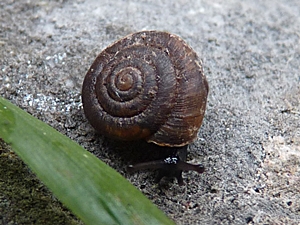 East alpine hair snail (Noricella oreinos). |
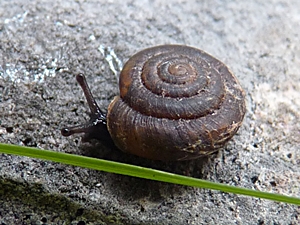 Photos: Martina Eleveld. |
Description: The shell of the East Alpine hair snail has a thicker wall than that of the common hair snail (Trochulus hispidus). The glossy surface of the shell is roughly and irregularly striped and finely granulated. The hairs are shorter (0,03 - 0,09 mm) and more curved than in Trochulus hispidus, however, about 80% of specimens lack any hairs. The last whorl of the shell displays a rounded keel. The shell mouth extends to a noticeably apertural lip, whose yellowish colour shines through to the outer side. The lower rim of the aperture displays one little tooth. The shell navel (umbilicus) covers about one sixth of the shell's diameter. In the eastern part of the distribution area, it is somewhat wider.
Dimensions: W: 5,5 - 7,5 mm; H: 3 - 4 mm.

Habitat and Distribution: The East Alpine hair snail lives in rocky habitats on limestone in the high mountains, mainly in areas free of vegetation under stones and between tufts of alpine grass and in the ground litter of alpine brushes. The species is found in elevations between 1400 and 2200 m MSL.
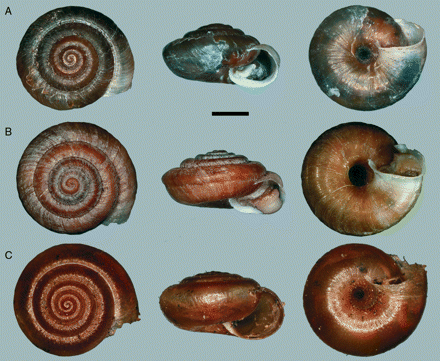 In comparison: A: Noricella oreinos. B: Noricella scheerpeltzi. C: Trochulus hispidus. Source: Duda et al. (2010). J. Moll. Stud. (Source). |
Note: The East Alpine hair snail occurs in two different forms, separated from each other by different distribution areas (parapatric). Morphologically, they are only distinguishable by the form of their keel: North of the Enns River, a second similar species, Noricella scheerpeltzi, could be isolated. That species is geographically and genetically well separated from Noricella oreinos, however morphologically hard to distinguish from the latter: Under the keel, the species scheerpeltzi displays a furrow.
Both East Alpine hair snail species do not occur together (sympatric) with the common hair snail (Trochulus hispidus), which they can be told apart from by the length and form of the shell hair. However they do exist in near vicinity. Only some time ago it could be proved morphologically, ecologically and genetically, that Noricella oreinos and Trochulus hispidus are distinct different species.
Systematics: 2017 Neiber, Razkin & Hausdorf (see below) were able to prove, that Noricella oreinos is not only an independent species, but even an independent genus. The group formerly known asTrochulus oreinos then was placed in an own genus Noricella Neiber, Razkin & Hausdorf 2017 (Noricum is the Roman province covering parts of the modern country of Austria). Additionally, Bamberger et al. 2020 (see below) were able to prove that Noricella scheerpeltzi constitutes an independent species, not a subspecies of Noricella oreinos.
Literature
Links
Villous Hair Snail - Trochulus villosus (Draparnaud 1805)
 Villous hair snail (Trochulus villosus). Mangfall, Miesbach, Ba- varia, Germany. |
 Trochulus villosus: Lower side. Photos: Felix Riegel (iNaturalist). |
Description: The villous hair snail has got a yellowish light grey to reddish brown shell with a roughly striped surface. In living specimens, the shell is covered in hairs 1,5 mm long, which are lost in dead shells, but also can be lost in living specimens. The shell tip (apex) is blunt and while the upper side of the shell is flattened, the sides are rounded. The last whorl descends a bit before the aperture. The aperture is rounded, the apertural lip is only weakly developed. The navel is wide and deep, widening to about one fifth of the shell's overall diameter.
 Enlarged view of a villous hair snail's shell. Especially well visi- ble: The striped sculpture of the shell surface and the long (1,5 mm) hairs. Photo: Felix Riegel (iNaturalist). |
The snail itself is of a lightly brownish colour with darker greyish tentacles.
Dimensions: H: 6 - 8 mm; B: 11 - 14 mm; U: 5½ - 6.

Habitat and Distribution: The villous hair snail lives in shady and humid habitats in higher elevations, mostly in forests. Only in areas with a high amount of precipitation, the species also can be found in open habitats, such as for example Alpine meadows.
Trochulus villosus is present in the northwestern and western Alps, as well as in southwestern Germany. Along the rivers, the species also occurs north of the Alps, for example along the Rhine River as far as Mainz, and the Danube River as far as Dillingen. In the Alps, the villous hair snail usually lives in elevations between 500 and 2000 m MSL, in Switzerland it is even found as high up as 2400 m MSL.
Threat Situation: While the villous hair snail is generally considered
as of little concern, in Rhineland-Palatinate and in Lower Saxony it is
considered endangered (![]() Threat categories according to IUCN
Red List).
Threat categories according to IUCN
Red List).
Systematics: A smaller subspecies (7 - 10 mm diameter on Alpine meadows, compared to 13 - 15 mm of the lowland variety) also with shorter hairs, Trochulus villosus alpicola Eder 1921 was described from the Western Alps. However, it cannot be a distinct species, since in the western distribution area of the villous hair snail there are numerous intermediate varieties. The smaller subspecies also displays the same surface sculpture of spiral lines as the main species. Smaller Alpine forms of the species are also known from different parts of the Alpine distribution area of Trochulus villosus.
Edentate Hair Snail - Petasina edentula (Draparnaud 1805)
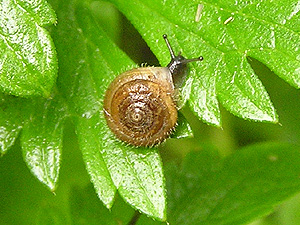 Edentate hair snail (Petasina edentula), on the right with a bush snail (Fruticicola fruticum). |
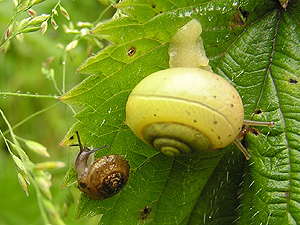 Photos: Robert Nordsieck. |
Description: The edentate hair snail has got a horn-coloured to reddish brown shell with a finely striped surface. The shell shape is variable, between flattened to conical. In juvenile specimens, the shell surface is densely covered with hairs, in adult specimens the hairs can sometimes be lost. The shell whorls are tightly coiled; the last whorl is slightly more strongly keeled. The small, sickle-shaped aperture on the inside displays a whitish lip, that on the basal side may be slightly thickened but does not display a tooth. The shell navel (umbilicus) is very narrow.
Petasina edentula is smaller than the similar Petasina unidentata; from the latter it is different by its more distinct shell keel, the narrower aperture and the missing apertural tooth.
The snail itself is light brown with a darker head and tentacles.
Dimensions: H: 4,5 - 5,5 mm; W: 7 - 8 mm; N: 6 - 6½.

Habitat and Distribution: The edentate hair snail lives between herbs and under leaves and stones in humid mountain forests with carcareous soil. Usually, Petasina edentula does not occur above the treeline, but sometimes it is also found in open forests and on stony Alpine meadows. Petasina edentula lives in elevations between 300 and 2300 m MSL.
The distribution area of the species extends from the western Alps north of the Durance River and the French Jura as far as the middle Swabian Jura, the northern Alps and in a dispersed pattern through the eastern Alps south until the Julian Alps. The edentate hair snail rarely occurs in the Alpine foothills.
Threat Situation: In Germany, the species is classified as threatened,
in Austria as near threatened (![]() Threat categories).
Threat categories).
Taxonomy: MolluscaBase displays the species as Edentiella edentula.
Unidentate Hair Snail - Petasina unidentata (Draparnaud 1805)
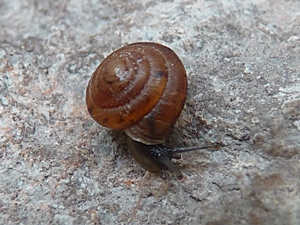 Unidentate hair snail (Petasina unidentata). |
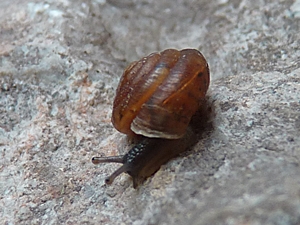 Photos: Martina Eleveld. |
Description: The unidentate hair snail has got a conical, tightly coiled shell of horn-like to reddish brown colour, which can display a more lightly coloured band on the last whorl. Juvenile specimens usually have a densely haired shell, while adult snails usually do not have hairs anymore. The aperture inside displays a whitish to pinkish coloured lip with a noticeable single tooth. The shell navel (umbilicus) is narrow. The species can be clearly distinguished from similar one by the characteristic tooth: The edentate hair snail (Petasina edentula) has no apertural tooth and the bidentate leaf snail (Perforatella bidentata) has two teeth.
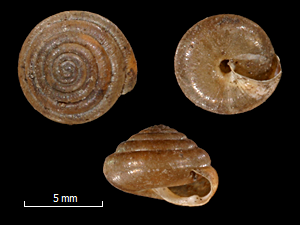 Unidentate hair snail (Petasina unidentata). Photo: Michal Manas. Source: Wikipedia. |
Dimensions: W: 5 - 9 mm; H: 3,5 - 6 mm; N: 5 - 7.

Habitat and Distribution: The unidentate hair snail lives in humid to moderately dry locations in forests, but also above the treeline. Petasina unidentata prefers rocks or stony habitats on calcareous soil. While the species typically occurs in elevations between 500 and 2000 m MSL., in Switzerland it can be found in up to 2300 m MSL.
Petasina unidentata is distributed between eastern Switzerland and
northern Italy as far as southern Poland, Hungary and Slovakia. Generally,
Petasina unidentata in the core of its distribution area is quite frequent,
so in the Vienna Woods it is among the most frequent species. In
Rhineland-Palatinate, however, it is considered extinct and in Germany it is
generally considered as severely threatened since 2009 (![]() Threat categories).
Threat categories).
The species Petasina unidentata can be divided in different subspecies:
Petasina unidentata unidentata (Draparnaud 1805): Poland, Germany, Switzerland, Liechtenstein, Austria, Czechia, Hungary, Slovakia, Romania.
Petasina unidentata alpestris (Clessin 1878): Germany, Austria.
Petasina unidentata bohemica (Ložek 1948): Czechia.
Petasina unidentata carpatica (Poliński 1929): Slovakia.
Petasina unidentata norica (Poliński 1929): Germany, Austria.
Petasina unidentata subalpestris (Poliński 1929): Germany, Switzerland, Austria, Italy.
Source: MolluscaBase (see below)
 With photos by Stefan Haller: http://www.schneckenfoto.ch. |
Latest Change: 28.09.2025 (Robert Nordsieck).